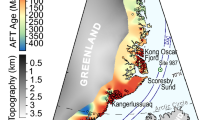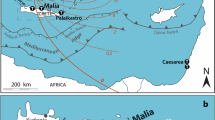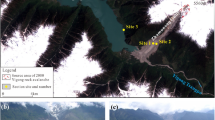Abstract
The timing and role of exhumation in the St Elias orogen, the world’s highest coastal mountain range, has been unclear. Sampling is limited to high mountain ridges that tower over widespread ice fields that sit in deeply eroded parts of the orogen. Existing bedrock studies1,2,3 in the region are therefore prone to bias. Here we analyse detrital material of active sediment systems in the St Elias orogen to obtain age information from the inaccessible ice-covered valley bottoms. We present 1,674 detrital zircon fission-track ages from modern rivers that drain the glaciers. We find a population of very young ages of less than 3 Myr from the Seward–Malaspina glacier systems that is sharply localized in the area of the orogen’s highest relief, highest seismicity and at the transition from transform to subduction tectonics. Our data provide evidence for intense localized exhumation that is driven by coupling between erosion and active tectonic rock uplift.
This is a preview of subscription content, access via your institution
Access options
Subscribe to this journal
Receive 12 print issues and online access
$259.00 per year
only $21.58 per issue
Buy this article
- Purchase on Springer Link
- Instant access to full article PDF
Prices may be subject to local taxes which are calculated during checkout



Similar content being viewed by others
References
Berger, A. L. et al. Architecture, kinematics, and exhumation of a convergent orogenic wedge; a thermochronological investigation of tectonic–climatic interactions within the central St. Elias Orogen, Alaska. Earth Planet. Sci. Lett. 270, 13–24 (2008).
Berger, A. L. & Spotila, J. A. Denudation and deformation in a glaciated orogenic wedge: The St. Elias orogen, Alaska. Geology 36, 523–526 (2008).
O’Sullivan, P. B. & Currie, L. D. Thermotectonic history of Mt Logan, Yukon Territory, Canada: Implications of multiple episodes of middle to late Cenozoic denudation. Earth Planet. Sci. Lett. 144, 251–261 (1996).
Plafker, G. in Geology and Resource Potential of the Continental Margin of Western North America and Adjacent Ocean Basins Vol. 6 (ed. Scholl, D. W.) 229–268 (Circum-Pacific Council for Energy and Mineral Resources, 1987).
Ferris, A., Abers, G. A., Christensen, D. H. & Veenstra, E. High resolution image of the subducted Pacific plate beneath central Alaska, 50–150 km depth. Earth Planet. Sci. Lett. 214, 575–588 (2003).
Bruhn, R. L., Pavlis, T. L., Plafker, G. & Serpa, L. Deformation during terrane accretion in the Saint Elias orogen, Alaska. Geol. Soc. Am. Bull. 116, 771–787 (2004).
Farley, K. A. Helium diffusion from apatite: General behaviour as illustrated by Durango fluorapatite. J. Geophys. Res. 105, 2903–2914 (2000).
Green, P. F., Duddy, I. R., Gleadow, A. J. W., Tingate, P. T. & Laslett, G. M. Thermal annealing of fission tracks in apatite: 1—a qualitative description. Isot. Geosci. 59, 237–253 (1986).
Brandon, M. T., Roden-Tice, M. K. & Garver, J. I. Late Cenozoic exhumation of the Cascadia accretionary wedge in the Olympic Mountains, northwest Washington State. Geol. Soc. Am. Bull. 110, 985–1009 (1998).
Meigs, A., Johnston, S., Garver, J. I. & Spotila, J. A. Crustal-scale structural architecture, shortening, and exhumation of an active, eroding orogenic wedge (Chugach/St Elias Range, southern Alaska). Tectonics 27, TC4003 (2008).
Koons, P. O., Zeitler, P. K., Chamberlain, C. P., Craw, D. & Meltzer, A. S. Mechanical links between erosion and metamorphism in Nanga Parbat, Pakistan Himalaya. Am. J. Sci. 302, 749–773 (2002).
Zeitler, P. K. et al. Crustal reworking at Nanga Parbat, Pakistan: Metamorphic consequences of thermal–mechanical coupling facilitated by erosion. Tectonics 20, 712–728 (2001).
Montgomery, D. R. & Stolar, D. B. Reconsidering Himalayan river anticlines. Geomorphology 82, 4–15 (2006).
Enkelmann, E., Garver, J. I. & Pavlis, T. L. Rapid exhumation of ice-covered rocks of the Chugach–St. Elias orogen, SE-Alaska. Geology 36, 915–918 (2008).
Bernet, M. & Garver, J. I. Fission-track analysis of detrital zircon. Rev. Mineral. Geochem. 58, 205–237 (2005).
Headley, R., Hallet, B. & Rignot, E. Measurements of fast ice flow of the Malaspina Glacier to explore connections between glacial erosion and crustal deformation in the St. Elias Mountains, Alaska. Eos Trans. AGU 88, C41A-0050 (2007).
Plafker, G., Moore, J. C. & Winkler, G. R. in The Geology of Alaska. Geol. N. America Vol. G-1 (eds Plafker, G. & Berg, H. C.) 389–449 (GSA, 1994).
Sisson, V. B. et al. in Geology of a Transpressional Orogen Developed During Ridge-Trench Interaction Along the North Pacific Margin (eds Sisson, V. B.et al.) 293–326 (Geological Society of America, 2003).
Elliott, J., Freymueller, J. T. & Larsen, C. F. Collisional Tectonics in the St. Elias orogen, Alaska, observed by GPS. Eos Trans. AGU 89 Fall Meet. Suppl., Abstract T44A-04. (2008).
Ruppert, N. A., Ridgway, K. D., Freymueller, J. T., Cross, R. S. & Hansen, R. A. in Active Tectonics and Seismic Potential of Alaska (ed. Freymueller, J. T.) 109–133 (Geophysical Monograph Series, Vol. 179, American Geophysical Union, 2008).
Tagami, T., Galbraith, R. F., Yamada, R. & Laslett, G. M. in Advances in Fission-Track Geochronolgy (eds Van den haute, P. & De Corte, F.) 99–112 (Kluwer–Academic, 1998).
Rahn, M. K., Brandon, M. T., Batt, G. E. & Garver, J. I. A zero-damage model for fission-track annealing in zircon. Am. Mineral. 89, 473–484 (2004).
Magoon, L. B. Present-day geothermal gradient, geologic studies of the lower Cook Inlet Cost No. 1 Well, Alaska outer continental shelf. US Geol. Surv. Bull. 1596, 41–46 (1986).
Johnsson, M. J., Pawlewicz, M. J., Harris, A. G. & Valin, Z. C. Vitrinite reflectance and conodont color alteration index data from Alaska: Data to accompany the thermal maturity map of Alaska. USGS Open-File Report 92-409 (1992).
Kamp, P. J. J., Green, P. F. & White, S. H. Fission track analysis reveals character of collisonal tectonics in New Zealand. Tectonics 8, 169–195 (1989).
Garver, J. I. & Kamp, P. J. J. Integration of zircon color and zircon fission-track zonation patterns in orogenic belts: Application to the Southern Alps, New Zealand. Tectonophysics 349, 203–219 (2002).
Garver, J. I. Etching zircon age standards for fission-track analysis. Radiat. Meas. 37, 47–53 (2003).
Brandon, M. T. Decomposition of fission-track grain-age distributions. Am. J. Sci. 292, 535–564 (1992).
Fletcher, H. J. & Freymueller, J. T. New GPS constraints on the motion of the Yakutat block. Geophys. Res. Lett. 26, 3029–3032 (1999).
Acknowledgements
We thank collaborators of the STEEP project for their help during field work and fruitful discussions. We also thank G. Gehrels and V. Valencia for their guidance on U/Pb dating. Sample irradiation was facilitated by the Reactor Use Sharing Program (US DOE) to the Oregon State Nuclear Reactor. A review by P. Reiners improved the manuscript significantly. This study was supported by the NSF grants, EAR-0409132 and 0735402.
Author information
Authors and Affiliations
Contributions
All authors contributed to the writing and interpretation. Data analysis was carried out by E.E., P.K.Z., J.I.G. and K.D.R., field work by E.E., T.L.P. and K.D.R. and project planning was done by T.L.P., P.K.Z. and K.D.R.
Corresponding author
Supplementary information
Supplementary Table S1
Supplementary Information (PDF 309 kb)
Rights and permissions
About this article
Cite this article
Enkelmann, E., Zeitler, P., Pavlis, T. et al. Intense localized rock uplift and erosion in the St Elias orogen of Alaska. Nature Geosci 2, 360–363 (2009). https://doi.org/10.1038/ngeo502
Received:
Accepted:
Published:
Issue Date:
DOI: https://doi.org/10.1038/ngeo502
This article is cited by
-
3D geodynamic-geomorphologic modelling of deformation and exhumation at curved plate boundaries: Implications for the southern Alaskan plate corner
Scientific Reports (2022)
-
The provenance signal of climate–tectonic interactions in the evolving St. Elias orogen: framework component analysis and pyroxene and epidote single grain geochemistry of sediments from IODP 341 sites U1417 and U1418
International Journal of Earth Sciences (2021)



